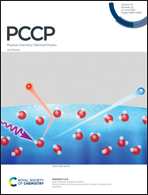Various bond interactions between NO and anionic gold clusters: a theoretical calculation†
Abstract
We studied the electronic and geometrical structures of AunNO− (n = 1–20) using the B3LYP method with relatively large basis sets to understand the size-dependent reactivities of Aun− with NO in recent experiments. In most cases, the Aun− in a AunNO− maintains its original geometries, and NO bonds with one gold atom in the N-atop pattern. The theoretical adsorption energy of NO in an even-sized AunNO− is generally larger than those in its odd-sized neighbors, which is consistent with the observed even-odd oscillation in experiments. Various bond interactions are identified between Aun− and NO according to analyses on the NO bond lengths, NO stretching frequencies, charge transfer extents, and densities of states of AunNO−. For the odd-sized AunNO− in their doublet states, the bonds between Aun− and NO can be described as weak dative bonds in the small size range, or even weaker electrostatic interactions for the large ones. For the even-sized AunNO− in their triplet states (with the exception of Au10NO− and Au16NO−), the electron transfer from Aun− to NO forms a triplet NO− and a neutral Aun, which bind together mainly through electrostatic interactions. The lowest-lying structures of Au10NO− and Au16NO− are in their singlets, and the bonds between NO and their gold parts can be described as polar covalent bonds. The stabilities of these two exceptional complexes are enhanced by the closed electron shells formed on their gold parts.



 Please wait while we load your content...
Please wait while we load your content...